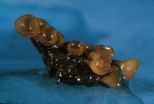(Press-News.org) ANN ARBOR, Mich.---The more complex a plant or animal, the more difficulty it should have adapting to changes in the environment. That's been a maxim of evolutionary theory since biologist Ronald Fisher put forth the idea in 1930.
But if that tenet is true, how do you explain all the well-adapted, complex organisms---from orchids to bower birds to humans---in this world?
This "cost of complexity" conundrum puzzles biologists and offers ammunition to proponents of intelligent design, who hold that such intricacy could arise only through the efforts of a divine designer, not through natural selection.
A new analysis by Jianzhi "George" Zhang and coworkers at the University of Michigan and Taiwan's National Health Research Institutes reveals flaws in the models from which the cost of complexity idea arose and shows that complexity can, indeed, develop through evolutionary processes. In fact, a moderate amount of complexity best equips organisms to adapt to environmental change, the research suggests. The findings will be published online in the Proceedings of the National Academy of Sciences during the week of Sept. 27.
The study focused on a genetic phenomenon called pleiotropy, in which a single gene affects more than one trait. Examples of pleiotropy are well known in certain human diseases, and the effect also has been documented in experimental animals such as fruit flies. Biologists also recognize its importance in development, aging and many evolutionary processes. However, pleiotropy is difficult to measure, and its general patterns are poorly understood, said Zhang, a professor of ecology and evolutionary biology.
Even so, scientists have developed mathematical models of the phenomenon, based on certain assumptions, and have made predictions from the results of the models. Zhang and coworkers decided to test the assumptions against real-life observations by analyzing several large databases that catalog the effects of specific genetic mutations on traits in model organisms (yeast, roundworms and mice). Each data set included hundreds to thousands of genes and tens to hundreds of traits.
For simplicity, mathematical models of pleiotropy have assumed that all genes in an organism affect all of its traits to some extent. But Zhang's group found that most genes affect only a small number of traits, while relatively few genes affect large numbers of traits.
What's more, they found a "modular" pattern of organization, with genes and traits grouped into sets. Genes in a particular set affect a particular group of traits, but not traits in other groups.
In addition, the researchers learned that the more traits a gene affects, the stronger its effect on each trait.
All of these findings challenge the assumptions underlying the classic mathematical models that suggest complexity is prohibitively costly.
When Fisher first wrote about the cost of complexity, he argued that random mutations---which, along with natural selection, drive evolution---are more likely to benefit simple organisms than complex organisms.
"Think of a hammer and a microscope," Zhang said. "One is complex, one is simple. If you change the length of an arbitrary component of the system by an inch, for example, you're more likely to break the microscope than the hammer."
In a paper published in 2000, evolutionary geneticist H. Allen Orr of Rochester came up with additional reasons for the cost of complexity. According to his model, even if a mutation benefits a complex organism, it's unlikely to spread throughout the whole population and become "fixed." And even if it does that, the advantage of the mutation is likely to be small.
By incorporating a more realistic representation of pleiotropy, Zhang's analysis found the reverse of Orr's arguments to be true. Although Fisher's observation still holds, reversing Orr's assertions minimizes its impact, thus reducing the cost of complexity.
Further, the analysis showed that the ability of organisms to adapt is highest at intermediate levels of complexity. "This means a simple organism is not best, and a very complex organism is not best; some intermediate level of complexity is best in terms of the adaptation rate," Zhang said.
The new findings help buffer evolutionary biology against the criticisms of intelligent design proponents, Zhang said. "The evolution of complexity is one thing that they often target. Admittedly, there were some theoretical difficulties in explaining the evolution of complexity because of the notion of the cost of complexity, but with our findings these difficulties are now removed."
INFORMATION: Zhang's coauthors on the paper are former U-M graduate student Zhi Wang, now at Sage Bionetworks in Seattle, Wash., and Ben-Yang Liao of the National Health Research Institutes in Taiwan.
Funding was provided by the U.S. National Institutes of Health and the Taiwan National Health Research Institutes.
More information:
Zhang: http://www.ns.umich.edu/htdocs/public/experts/ExpDisplay.php?ExpID=1161
Proceedings of the National Academy of Sciences: http://www.pnas.org/
END
Software downloaded during a routine office visit cuts the risk of inappropriate shocks by 50 percent for patients with implantable cardioverter defibrillators (ICD), according to research reported in Circulation: Journal of the American Heart Association.
"Hundreds of patients have been saved from unnecessary shocks by software that is safe and can be painlessly downloaded in one minute during a standard defibrillator check," said Charles D. Swerdlow, M.D., lead author of the study and a cardiac electrophysiologist at the Cedars Sinai Heart Institute in Los Angeles and ...
Using data from more than 270,000 hospital stroke admissions, scientists have identified how to predict which patients are at greatest risk of dying in the hospital after stroke. Before their study, well validated models to predict in-hospital death risk after stroke were lacking, the researchers reported in Circulation: Journal of the American Heart Association.
"A mortality risk assessment tool for hospitalized stroke patients is important to clinicians, hospitals and patients," said Eric E. Smith, M.D., M.P.H., lead author of the study and assistant professor of neurology ...
VIDEO:
In a few tenths of a second, Sclerotinia expels hundreds of thousands of spores in a plume that can rise 20 cm, much higher than any single spore by itself....
Click here for more information.
Long before geese started flying in chevron formation or cyclists learned the value of drafting, fungi discovered an aerodynamic way to reduce drag on their spores so as to spread them as high and as far as possible.
One fungus, the destructive Sclerotinia sclerotiorum, ...
In a paper published this week in the Proceedings of the National Academy of Sciences, Cary Institute aquatic ecologist Dr. Emma Rosi-Marshall and colleagues report that streams throughout the Midwestern Corn Belt are receiving insecticidal proteins that originate from adjacent genetically modified crops. The protein enters streams through runoff and when corn leaves, stalks, and plant parts are washed into stream channels.
Genetically-modified plants are a mainstay of large-scale agriculture in the American Midwest, where corn is a dominant crop. In 2009, more than ...
Burness Communications
Godwin Atser
g.atser@cgiar.org
234-803-443-0027
CGIAR
Scientists arrive in Senegal to give African hunger a black eye
At the World Cowpea Research Conference, crop experts embrace one of agriculture's oldest legumes -- prized for protein and resilience to hot, dry climates -- as food for people, livestock and astronauts
This release is available in French.
DAKAR, SENEGAL (27 September 2010)—A long neglected crop with the potential to halt hunger for millions in Africa, sustain the livestock revolution underway in developing countries, ...
Researchers in the Midwest are developing microelectronic circuitry to guide the growth of axons in a brain damaged by an exploding bomb, car crash or stroke. The goal is to rewire the brain connectivity and bypass the region damaged by trauma, in order to restore normal behavior and movement.
Pedram Mohseni, a professor of electrical engineering and computer science at Case Western Reserve University, and Randolph J. Nudo, a professor of molecular and integrative physiology at Kansas University Medical Center, believe repeated communications between distant neurons in ...
Baby boomers appear to be driving a dramatic rise in suicide rates among middle-aged people, a new study finds.
The suicide rate for middle-aged people – a group considered relatively protected from suicide and with historically stable suicide rates – took an upward jump between 1999 and 2005, according to research by sociologists Ellen Idler of Emory University and Julie Phillips of Rutgers University.
Their study has been published in the September/October issue of the journal Public Health Reports.
"The findings are disturbing, because they're a reversal of a long-standing ...
A report presented today by Health and Consumer Policy Commissioner John Dalli to the Agriculture Council concludes that specific measures relating to storing and the application of isolation distances can help limit or avoid the co-mingling of genetically modified (GM) maize with conventional and organic maize. In particular, the Best Practice Document, prepared by the European Coexistence Bureau (ECoB) and published by the European Commission's Joint Research Centre (JRC), notes that storing seeds adequately and applying spatial isolation are the best ways to limit or ...
TORONTO, Sept. 27, 2010 − Homeless young people are victims of crime at rates that society would consider unacceptable for any other group, according to a new report by researchers at York University and the University of Guelph.
The report, Surviving Crime and Violence: Street Youth and Victimization in Toronto, highlights the degree to which it is street youth themselves − often perceived as delinquent and dangerous − who are vulnerable to crime and violence.
"The very people we are taught to fear are the ones who are most at risk," said Professor ...
Researchers have long held that there are steps that can be taken to make brainstorming sessions more productive. New research from North Carolina State University finds that these recommendations actually do contribute to success when applied in real-world business environments.
"Previous research has laid out best practices that are conducive to brainstorming, or group decision making, and we wanted to see whether using those practices makes a difference in the real world," says Dr. Joe Brazel, associate professor of accounting at NC State and co-author of a paper describing ...

